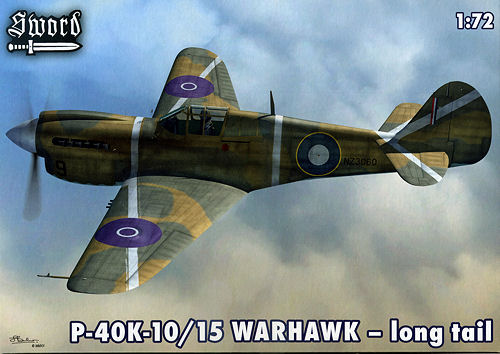
Sword 1/72 P-40K-10/15 Warhawk
| KIT #: | SW 72065 |
| PRICE: | $44.95 SRP |
| DECALS: | Three options |
| REVIEWER: | Scott Van Aken |
| NOTES: |

| HISTORY |
The Curtiss P-40 Warhawk was an American single-engine, single-seat, all-metal fighter and ground attack aircraft that first flew in 1938. The P-40 design was a modification of the previous Curtiss P-36 Hawk which reduced development time and enabled a rapid entry into production and operational service. The Warhawk was used by the air forces of 28 nations, including those of most Allied powers during World War II, and remained in front line service until the end of the war. It was the third most-produced American fighter, after the P-51 and P-47; by November 1944, when production of the P-40 ceased, 13,738 had been built, all at Curtiss-Wright Corporation's main production facilities at Buffalo, New York.
Warhawk was the name the United States Army Air Corps adopted for all models, making it the official name in the United States for all P-40s. The British Commonwealth and Soviet air forces used the name Tomahawk for models equivalent to the P-40B and P-40C, and the name Kittyhawk for models equivalent to the P-40D and all later variants.
P-40s first saw combat with the British Commonwealth squadrons of the Desert Air Force in the Middle East and North African campaigns, during June 1941. The Royal Air Force's No. 112 Squadron was among the first to operate Tomahawks, in North Africa, and the unit was the first Allied military aviation unit to feature the "shark mouth" logo, copying similar markings on some Luftwaffe Messerschmitt Bf 110 twin-engine fighters.
The P-40's lack of a two-stage supercharger made it inferior to Luftwaffe fighters such as the Messerschmitt Bf 109 or the Focke-Wulf Fw 190 in high-altitude combat and it was rarely used in operations in Northwest Europe. Between 1941 and 1944, however, the P-40 played a critical role with Allied air forces in three major theaters: North Africa, the Southwest Pacific and China. It also had a significant role in the Middle East, Southeast Asia, Eastern Europe, Alaska and Italy.
The P-40K variant was used wherever the earlier versions flew. It was considered to be the heaviest and slowest of all versions. This aircraft often had the extended fin fillet, though this feature was not unique to the K. In order to improve performance, Curtiss developed an Allison engine version of the lightened P-40L. These later K versions had the same extended fuselage, but maintained the six gun armament of earlier versions. Most were provided to British and commonwealth air forces.
| THE KIT |
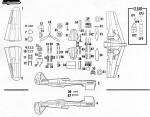 This
kit is pretty much the same as the earlier short fuselage K. In fact, my kit
came with one early K fuselage half! In addition to those same parts, two new
long tail fuselage halves were included in the kit. It is a typical short run kit with a bit of flash and some mold 'stuff' on
the spinners that will be easily removed. I thought that the fuselage interior
detail was pretty well done so that should please several. The clear bit
This
kit is pretty much the same as the earlier short fuselage K. In fact, my kit
came with one early K fuselage half! In addition to those same parts, two new
long tail fuselage halves were included in the kit. It is a typical short run kit with a bit of flash and some mold 'stuff' on
the spinners that will be easily removed. I thought that the fuselage interior
detail was pretty well done so that should please several. The clear bit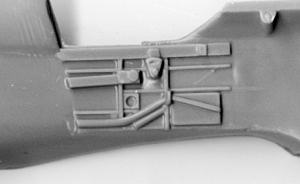 s
consist of a canopy/windscreen piece with the rear quarter windows being
separate. This will make it much easier to paint the scalloped area under them.
The cockpit is nicely done with raised instrument panel detail as well as a nice
seat rail on which the seat is placed then glued to the armor plating. There are
no seat belts but these can easily be added.
s
consist of a canopy/windscreen piece with the rear quarter windows being
separate. This will make it much easier to paint the scalloped area under them.
The cockpit is nicely done with raised instrument panel detail as well as a nice
seat rail on which the seat is placed then glued to the armor plating. There are
no seat belts but these can easily be added.
The exhaust can be installed from the outside, once an 'L' shaped backing plate is glued on the inside of the nose section. In addition to the usual coolant radiators, this kit also has the exit radiator section, which will probably be visible if you install the optional open cowl flap piece. Each of the main gear wells needs to be boxed in with four pieces. There is also a separate gun insert for the lower part of the wing leading edge. This should have the guns in the proper position instead of the center of the leading edge as most other kits have portrayed in the past. The lone option is either open or closed cowl flaps. Also the only thing that can be carried under the fuselage is a drop tank. This has four separate tank braces so you might want to work out an easy way to do this. I would glue the braces to the fuselage first and use the drop tank to test whether they are at the right inward angle.
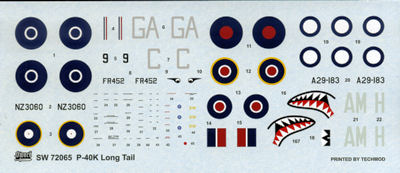 There are
three markings options. The first is a New Zealand aircraft in Dark Earth,
Foliage Green and Sky as based on
There are
three markings options. The first is a New Zealand aircraft in Dark Earth,
Foliage Green and Sky as based on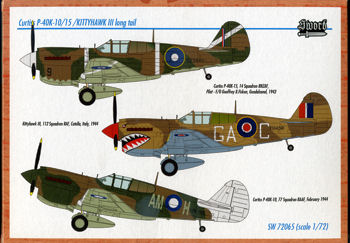 Guadalcanal in early 1943. All of the white bits will need to be painted and
that alone will prevent many from attempting this scheme as the bands are pretty
extensive. I do not see why at least most of these bands could not have been
included in the decals. I also noticed that the wing stripes are a bit different
in the instructions compared to the box art. Next is a 112 Squadron aircraft
based in Italy during 1944. It is in Dark Earth, Midstone and Azure Blue. The
final option is an Australian plane with 77 Squadron in early 1944. This one is
also Dark Earth, Foliage Green and Sky with a full white empennage and white
wing leading edges. A
full stencil suite is provided and the instructions devote two pages to their
installation.
Guadalcanal in early 1943. All of the white bits will need to be painted and
that alone will prevent many from attempting this scheme as the bands are pretty
extensive. I do not see why at least most of these bands could not have been
included in the decals. I also noticed that the wing stripes are a bit different
in the instructions compared to the box art. Next is a 112 Squadron aircraft
based in Italy during 1944. It is in Dark Earth, Midstone and Azure Blue. The
final option is an Australian plane with 77 Squadron in early 1944. This one is
also Dark Earth, Foliage Green and Sky with a full white empennage and white
wing leading edges. A
full stencil suite is provided and the instructions devote two pages to their
installation.
| CONCLUSIONS |
It is nice to have a kit available in this scale of this P-40 version as it is so frequently overlooked by kit makers. I like that Sword did all new fuselage halves for this one and anticipate similar means to do perhaps the Merlin powered types that one so rarely sees in 1/72. This one belongs in the collection of any 1/72 P-40 fan.
| REFERENCES |
http://en.wikipedia.org/wiki/P-40_Warhawk
November 2012
Thanks to Squadron Products for the preview kit. If your local shop does not have it, have them order it for you.
If you would like your product reviewed fairly and fairly quickly, please contact the editor or see other details in the Note to Contributors.